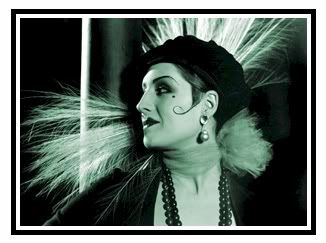 Lady of the Night is, for all intents and purposes, a vehicle for Norma Shearer, still a relative newcomer and a nascent star in 1925. Norma plays two characters of of decidedly different backgrounds--on the one hand is Florence, a respectable daughter of a judge and a society darling, and on the other is Molly, a girl who was raised on the mean city streets. Another interesting contrast between the two girls is the fact that Florence grew up without a mother, while Molly grew up without a father (we see Molly's father hauled off to jail at the beginning of the picture, having been proclaimed guilty by none other than Judge Banning, Florence's father). By a cruel twist of fate, Florence and Molly both fall in love with the same man, a successful inventor named David Page (played by Malcolm McGregor, who, by the way, was a native of Newark, New Jersey). The situation is complicated by the fact that Molly was previously entangled in a shaky relationship with David's friend "Chunky" Dunn (played by George K. Arthur). Although Molly spurns him in favor of his more successful and more handsome friend, Chunky nevertheless tirelessly venerates her.
Lady of the Night is, for all intents and purposes, a vehicle for Norma Shearer, still a relative newcomer and a nascent star in 1925. Norma plays two characters of of decidedly different backgrounds--on the one hand is Florence, a respectable daughter of a judge and a society darling, and on the other is Molly, a girl who was raised on the mean city streets. Another interesting contrast between the two girls is the fact that Florence grew up without a mother, while Molly grew up without a father (we see Molly's father hauled off to jail at the beginning of the picture, having been proclaimed guilty by none other than Judge Banning, Florence's father). By a cruel twist of fate, Florence and Molly both fall in love with the same man, a successful inventor named David Page (played by Malcolm McGregor, who, by the way, was a native of Newark, New Jersey). The situation is complicated by the fact that Molly was previously entangled in a shaky relationship with David's friend "Chunky" Dunn (played by George K. Arthur). Although Molly spurns him in favor of his more successful and more handsome friend, Chunky nevertheless tirelessly venerates her.It's less than revolutionary plot notwithstanding, Lady of the Night is a surprisingly good movie. Norma demonstrates just how good an actor she was in her day, turning in highly believable performances as two extremely different characters. Norma's Molly is especially sympathetic--she communicates with great effectiveness the exterior toughness, the interior nobility and the profound sadness and loneliness of a woman who feels unworthy of the man she loves (not that such a sentiment in inherently feminine, mind you).
Even if it were not a well-acted production, Lady of the Night would still be notable simply for being a damned lovely picture to look at. Rather than appearing simple black and white, Lady of the Night was shot on film that employs a variety of color tints that, aside from enhancing the various moods of the picture, also make Lady of the Night a beautiful sight to behold. That the film survives in remarkably good condition also enhances the visual aspect of the picture.
Finally, the enjoyability of the film for a modern viewer is enhanced by a modernized piano score (courtesy of Turner Classic Movies and composer Jon Mirsalis). The musical accompaniment fits the tone and feeling of the picture quite well, and never sounds out of place or exaggerated.
 Lady of the Night was quite a pleasant surprise for me--it exceeded my expectations rather greatly. I wouldn't go so far as to call it a masterpiece of the cinema, but it nevertheless was a delight to watch. It also helps that Norma Shearer is rather pleasant to look at, especially when she appears as Molly; despite--or perhaps because of--Molly's somewhat trampy makeup, she is disquietingly beautiful (evidence of this can be seen on the right). But I digress. For fans of silent film, I can recommend Lady of the Night without a hint of hesitance.
Lady of the Night was quite a pleasant surprise for me--it exceeded my expectations rather greatly. I wouldn't go so far as to call it a masterpiece of the cinema, but it nevertheless was a delight to watch. It also helps that Norma Shearer is rather pleasant to look at, especially when she appears as Molly; despite--or perhaps because of--Molly's somewhat trampy makeup, she is disquietingly beautiful (evidence of this can be seen on the right). But I digress. For fans of silent film, I can recommend Lady of the Night without a hint of hesitance.[Image Source]
No comments:
Post a Comment